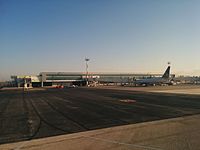Daniel Oduber International Airport
|
Daniel Oduber Quirós International Airport (LIR) Liberia International Airport |
|||||||||||
|---|---|---|---|---|---|---|---|---|---|---|---|
 |
|||||||||||
 |
|||||||||||
| Summary | |||||||||||
| Airport type | Public | ||||||||||
| Operator | Coriport S.A. | ||||||||||
| Location | Liberia, Guanacaste Province, Costa Rica | ||||||||||
| Elevation AMSL | 82 m / 269 ft | ||||||||||
| Coordinates | 10°35′35″N 085°32′44″W / 10.59306°N 85.54556°WCoordinates: 10°35′35″N 085°32′44″W / 10.59306°N 85.54556°W | ||||||||||
| Website | Liberia Airport | ||||||||||
| Map | |||||||||||
| Location in Costa Rica | |||||||||||
| Runways | |||||||||||
|
|||||||||||
| Statistics (2015) | |||||||||||
|
|||||||||||
|
Source: Directorate General of Civil Aviation of Costa Rica. GCM Google Maps
|
|||||||||||
| Passengers | 878,365 |
|---|---|
| Passenger change 14–15 |
|
Daniel Oduber Quirós International Airport (Spanish: Aeropuerto Internacional Daniel Oduber Quirós) (IATA: LIR, ICAO: MRLB), also known as Liberia International Airport, is one of four international airports in Costa Rica. The airport is located in the city of Liberia in Guanacaste Province. It serves specially as a tourism hub for those who visit the Pacific coast and Western Costa Rica. The airport is named for Daniel Oduber Quirós, who served as president of Costa Rica from 1974 to 1978.
Daniel Oduber Quirós International airport is the country's second and Central America's ninth busiest airport. In 2015, Liberia International Airport reported 878,365 passengers, a 12.7% increase compared to 2014.
The idea for an airport in the province of Guanacaste was initially conceived during the government of Daniel Oduber Quirós (1974–1978). The airport was initially named "Llano Grande", due to the name of the area that it was built in. It would later be named "Aeropuerto Tomas Guardia", and the last name it received is that of ex-president Daniel Oduber Quirós, in honour of his work for the province of Guanacaste. However, most people call it "Liberia International Airport".
In October 1995 the airport was re-inaugurated as an international airport. To support this expansion of operations, the pavement on the runway was redone and special landing lights were installed. Also a firefighter station was added to comply with FAA and international regulations. Initial response from commercial airlines to the expansion was timid; however, after one year the airport went from having only one weekly charter flight to one almost every day.
...
Wikipedia

